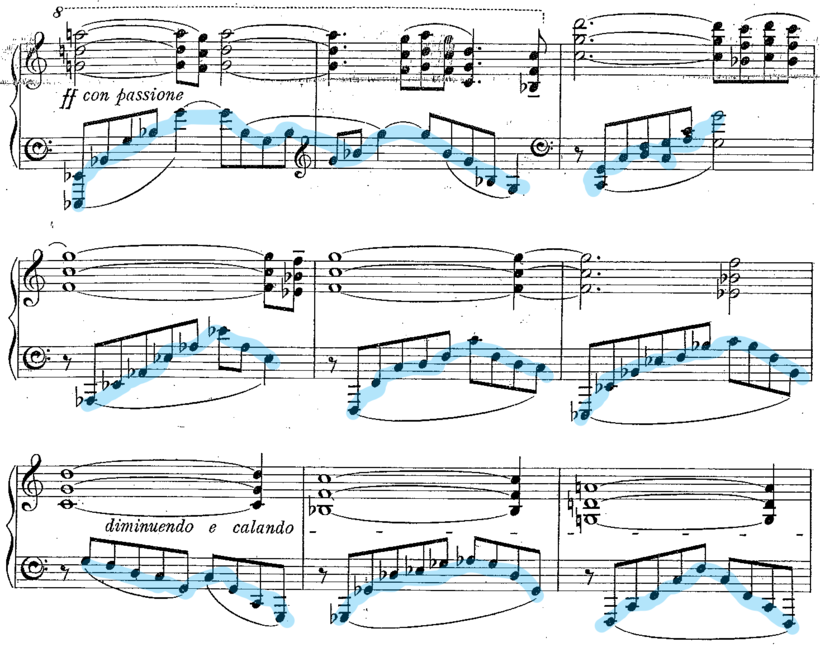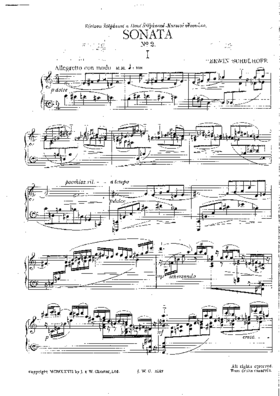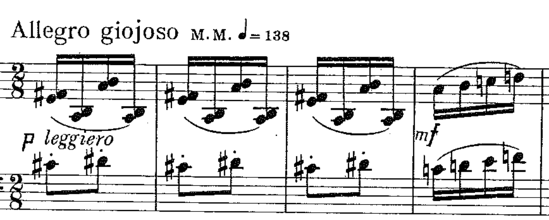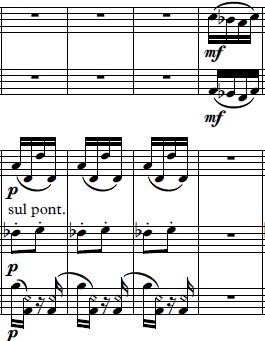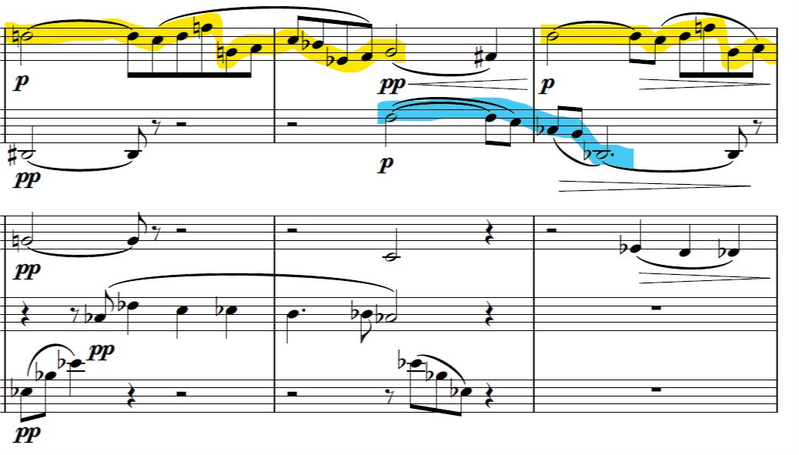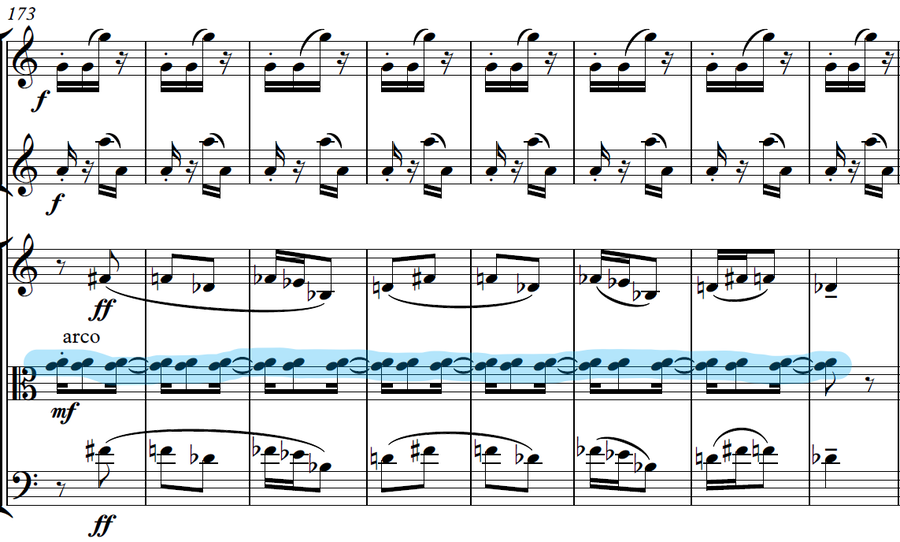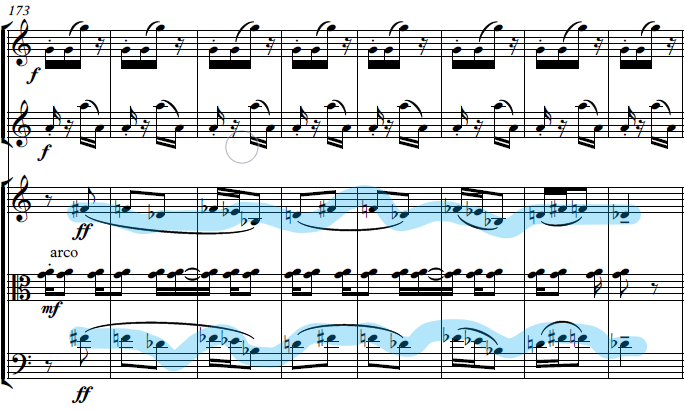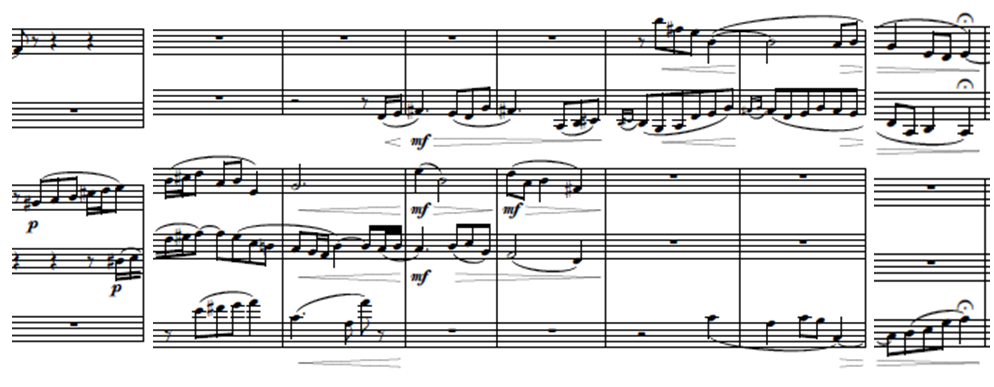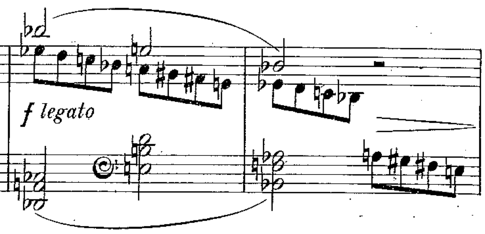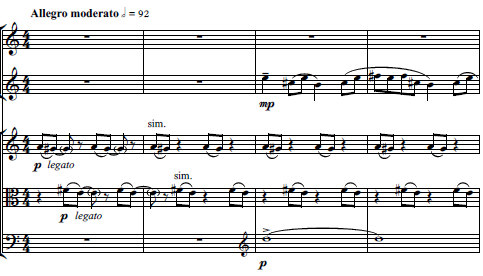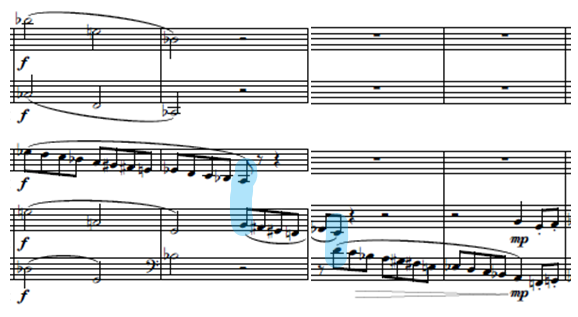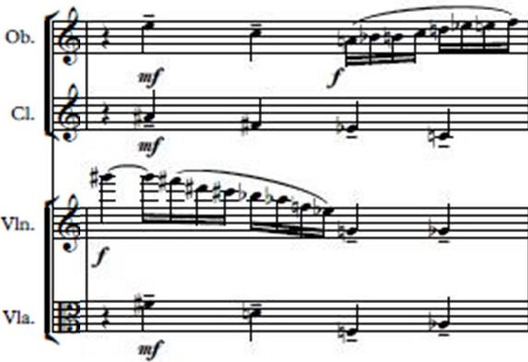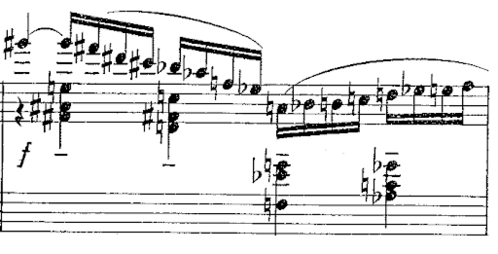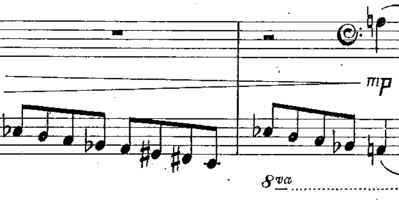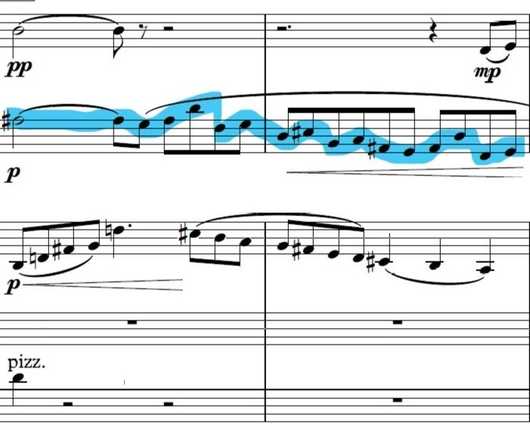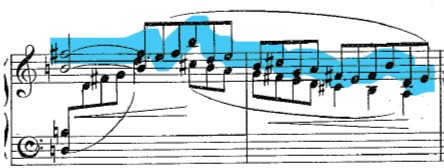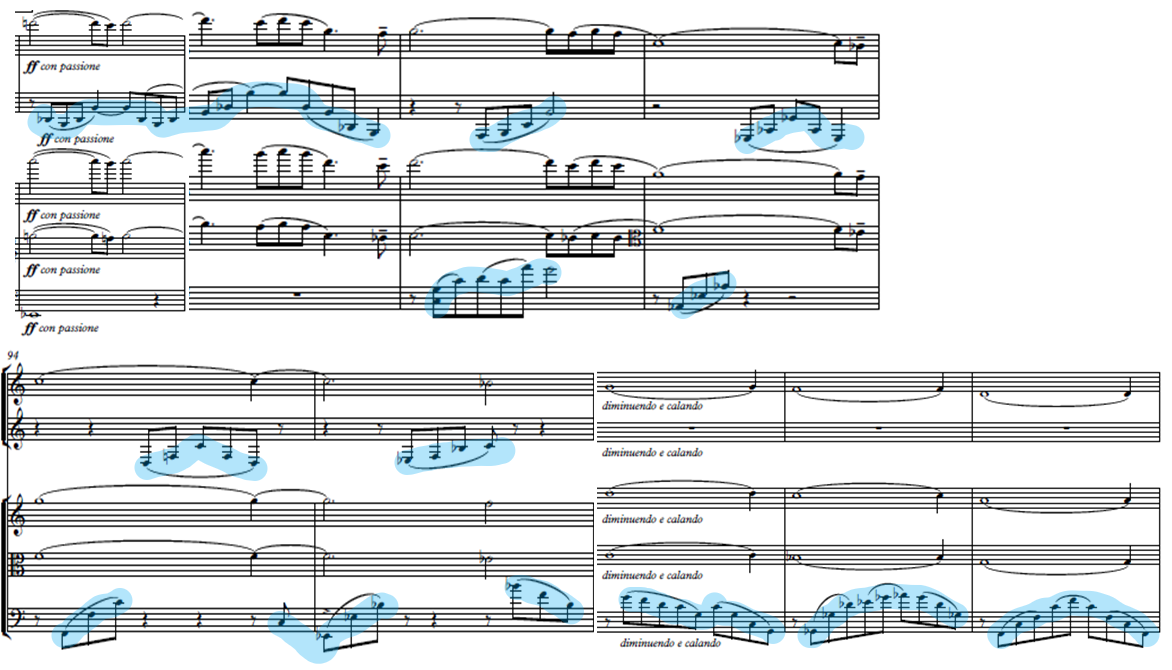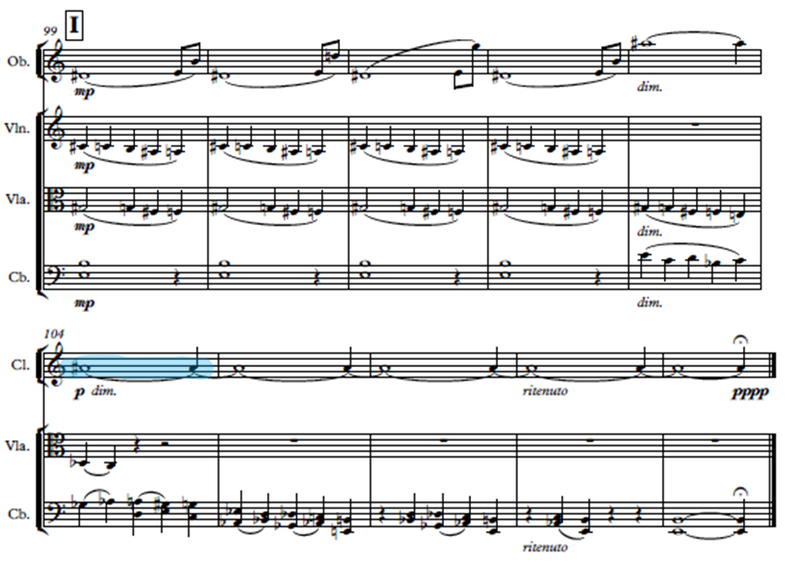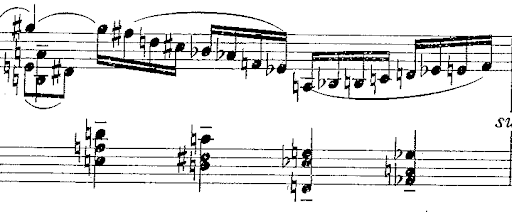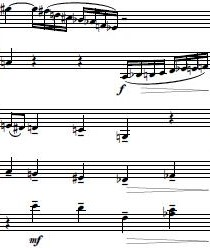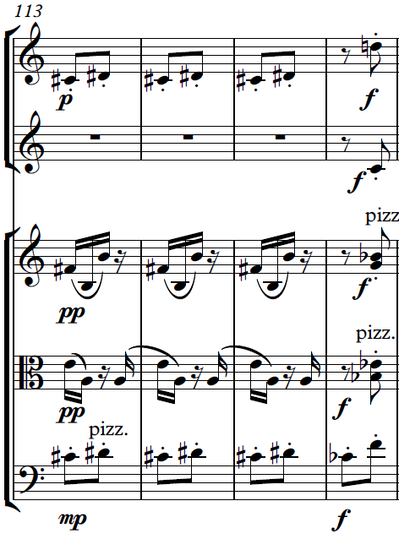Why I should make this arrangement
Personal motivations
Much like many of the double bassists from the 20th century, I too have a fascination with reworking existing music and presenting it in a new original form. Initially as a young curious bass player I was testing out how capable I was at playing violin or cello repertoire on this mammoth of an instrument. Eventually this transformed into a desire to explore not so much the possible technical prowess but rather the overall resulting musical soundscape that could be created. Arranging became the next logical step, providing an outlet for this curiosity. Once I began playing with Trapèze the opportunity to delve into this exploration of unique sound worlds was thrown upon me.
Appreciating an underrated ensemble
Performing Prokofiev’s quintet op. 39 introduced me to not only the challenging, charismatic and colourful music of the quintet, but also to an instrumentation that has so much potential. This was the first known work written for this combination, and since Prokofiev’s giant first step, only a handful of contemporary composers have followed suit. Therefore, there is a definite lack of repertoire for this highly capable quintet. My own wants aside, the quintet needs more repertoire and I felt a responsibility not only to my colleagues but to the ensemble itself to expand the repertoire.
Revitalising forgotten music
Much like the way this instrumentation lacks the attention I believe it is worthy of, countless compositions are lost in the tides of global creative output. Undoubtedly, a sizable percentage may be better off in obscurity, however there are many composers and unknown works that perhaps deserve a little more attention. In some cases, it may be the presentation rather than the musical substance that is to blame. Creating an arrangement can present the same musical core in a different light, potentially breathing life into a work that may have otherwise been forgotten. After coming across the piece I eventually would arrange, I felt this aspect of ‘revitalising’ was completely applicable for such a considerable work.
The rationale for choosing the work to arrange
General considerations
Probably, the single most important decision in making an arrangement is choosing the work to arrange. Once you have decided to make an arrangement for a particular ensemble, many factors must be considered. Firstly, thinking like a programmer, consider if this is going to be performed for a particular occasion, having to fit alongside other pieces, or will it just be a stand-alone work to extend the ensemble’s repertoire. What limitations does your ensemble have, and what ways can you overcome these limitations, and more importantly what are the strengths of the ensemble and how these be explored within the arrangement?
I knew that the Prokofiev will undoubtedly be on the program. It is the core and founding work of this ensemble and the reason we all came together in the first place. It has and will continue to be a source of inspiration and much like the string quartet has Haydn, Mozart and Beethoven, Prokofiev will be the ‘home’ we can always return to. Considering this, I could choose to create something contrasting to his musical world, however I felt, at least in this first arrangement, I would like to stay relatively close to the spirit and nature of Prokofiev’s op. 39.
The exploration phase
The next step for me involved a gargantuan amount of listening, exploring the musical back alleys, trying to find something that would work with our ensemble. I had the additional desire to find something that was almost completely unknown. There is so much music out there in the world and I wished to try unearth some gems from their obscurity.
My starting point was Prokofiev, father and genius of this instrumentation. He of course has many paths leading from him which one can follow. Most directly, there are some piano works of his which I thought would work beautifully, in particular his Visions Fugitives, however I thought this would be best left to another occasion as a full program of only Prokofiev seems a bit too much. I was drawn to his time in Paris, the place where he worked on his Quintet op.39. Following the connections to his associates, I came across a strong thread between him and Poulenc. I was introduced to his Oboe sonata, a beautifully melodious work dedicated to his dear friend Prokofiev, which seemed an interesting and contextually fitting work to arrange. This would come to naught as I was faced with an unconsidered limitation; the legal restrictions of arranging 20th century composers (dead for less than 70 years) and the unwavering stubbornness of the deceased composer’s current foundations.
So now my search was narrowed. For simplicity, I looked for composers who died before 1948, hence avoiding the 70 year copyright restriction. This of course points to a very particular set of the composers, those who died during World War II.
First encounter with Schulhoff
I had come across the Czech composer Erwin Schulhoff as I had played his Concertino for flute, viola and double bass. His music has an extremely broad range of styles however tends to incorporate his deeply seeded folk roots often with a fresh jazzy touch, not dissimilar to Prokofiev. He was extremely popular in his time with a promising career ahead, making his succumb to tuberculosis in 1942 in a concentration camp in Wülzburg, Bavaria, all the more tragic.
I listened to a lot of his music, scouring for something fitting. His two string quartets plus 5 pieces for string quartet as well as his string sextet are all fantastic works however were too suited for their string settings to be meddled with. Then I delved into his piano works. Being a pianist himself, there was quite some material. A lot of his piano writing was meant for the dance halls, with a mix of rag-times, foxtrots, tangos and the like. As delightful as they may be, they didn’t quite fit what I was imagining. Turning to his ‘serious’ writing I found more promise. His Piano Sonata no. 1 was my first choice. It is an extremely colourful work with a playfulness and innocence that I thought I could capture. However after checking the score and starting to think about it practically, I realised it didn’t quite fit with the instrumentation. Schulhoff often uses the low register of the piano in a way that is unadaptable for our ensemble, with its limited reach into the low registers. As deep and supportive as the bass can be, imitating densely packed chords in the left hand is just not possible. Of course one could rework the piece to make some kind of compromise, though this was only one of several hesitations I had about this particular work.
So I started searching again, but only briefly.
Finding the work: Schulhoff’s second piano sonata
It turned out that his Piano Sonata no. 2 is exactly what I was looking for. I had an enthusiasm when I heard the first sonata, however I wasn’t convinced. Though when listening to the second I already heard the arrangement unfolding before me. Like his first sonata, the second has diverse palate of colours, textures and characters, however more refined and contrasting. The counterpoint in all four movements was crying out to become an interweaving musical conversation, and fitted almost perfectly into all five voices. I was moved by the work, with its array of emotions and characters, the harmonic complexity juxtaposing its melodic simplicity and ultimately the overall joy I felt when listening to its entirety.
How I made the arrangement
Listening and imagining
To begin the actual arranging process, I spent many hours just listening to the work. My preferred recording was from the album Schulhoff: Piano Works Vol. 2 by Caroline Weichert, a slower yet perhaps more reflective performance than the recording of Schulhoff himself. I found the clear and dramatically different characters between all four movements in Caroline’s performance inspiring, as it pointed towards how the diverse colours of the quintet could explored. The first movement feels like a voyage, sea-like in its contours and almost Debussian in its harmonies. I could picture the entire quintet surging through these metaphorical waves, rolling and twisting over one another only to subside to a calm. The contrast could not be more apparent in the second movement, its witty playfulness and sparkle makes this extremely short movement a burst of energy and life. The , introspective
When listening I would have the score in front of me and with a pencil mark which instrument or combination of instruments I could imagine playing which line. The page became scattered with numerous markings; vln. ob. cl. vla. and db. As this is piano music, often with a single continuous melodic line, it is not always clear where you could pass a melody between instruments. Limiting an entire melodic phrase to one instrument all the time felt like it would defeat the purpose of arranging for quintet, where one of the core strengths lie in the possibility for dialogue between musicians. A musical conversation is more engaging than an extended monologue. Where to divide this musical line therefore became one of several challenging questions that I was faced with. Musical intuition as well as a great degree of problem solving became my go-to resources.
Aside from what sounds convincing for one particular sub-phrase, the longer line and intern entire work must also be considered. Many times I would need to shuffle around the instrumentation of a shared melodic line to make sure the overall impact feels balanced and cohesive.
Examining a small musical fragment: how it reflects the broader arranging process
Before delving into each of the different challenges that were faced, here is a small fragment to demonstrate some of the various thought processes that were employed throughout arranging the entire work. It may be easier to understand the following descriptions after first having a brief encounter with the practicalities involved. Consider this small fragment below, a delicate interweaving passage from the first movement of the Schulhoff Piano Sonata.
Here I wanted to create an effect of two voices continually talking over one another, as though they are unable to contain their excitement, jumping in before the other has finished. There are many ways to go about this. You could use only two instruments, each alternating with the high D entrances in the first 3 bars, followed by the F# in the 4th. Or you could add a third voice throughout or just for the F#, giving a sense of a more open discussion. For instruments, I chose to use the two woodwinds for the melodic material. Firstly because the colour difference between the oboe and clarinet is striking, whereas the violin and viola may not distinguish themselves so clearly. A woodwind string combination would also be possible, however as we tend to stand in the formation, going from left to right from the perspective of the audience, oboe, violin, viola, double bass then clarinet, the woodwinds are furthest apart, creating not only an audible distinction between the two voices, but adding a visual element as well. Then I needed to consider the material before and after this passage in order to see whether the oboe or clarinet should begin the phrase. I would need to check the voice leading and balance of the distribution between the instruments. In some cases I would change the previous or proceeding material to accommodate a particular moment, such as this, where I may feel strongly about how such a passage should sound. This is how I arranged these 5 bars, after all these possibilities considered. In this case I wanted the clarinet to play the F# and continuing descending line as the oboe will then take over with melodic material naturally fitting to the oboe in the next bars.
As you can see in the original from the piano score, the dynamics are limited to pp with a few hair pins. However, I felt there is an implied importance in the re-articulation of each D, so I tried to demonstrate this with a p for each new interruptive entrance as opposed to the to the pp of the accompaniment.
Looking more closely at the accompaniment of the first 2 bars, one must decide what to do with the ascending arpeggiated quavers in the left hand. If one is to be true to the notes on the page, then these are only playable on the double bass. The viola only reaches a C and the A clarinet only a C# above the asked Eb. It could be possible that the entire counter melody is played on the bass, however it would be quite technically demanding, requiring a large shift and a probable change in colour due to the use of the high register. Since it is such a soft delicate moment, such activity in the bass’s left hand may not fit with the context. By sharing the line with the viola, the line can continue more seamlessly and a counter conversation can now be created, ending with a somewhat symmetrical descent back to the bass. This interaction shouldn’t distract from the more prominent voices, but just adds a degree of liveliness and interactive chamber music to the moment. I often apply this strategy throughout the entire piece, as it returns extremely often, as it is quite a pianistic feature.
For the remaining 3 bars, the violin takes over the counter melody. I could have kept it with the viola, however I wanted to spread the music throughout the ensemble, especially at such an exploratory moment. Here I had to make a decision about where this line should begin. As you can see in the score, I decided the clarinet line should include the Ab, G and Bb from bar 3. It is this residual material after the initial D from bar 2 that inspired me to make this overlapping effect in the first place. But I believe, and I think Schulhoff has made it clear with his phrasing, that the following Eb should belong to a different line. Firstly because it is a restatement of the same descending chromatic material the viola had 2 bars prior and secondly as the arrival to the Bb in the clarinet feels like somewhat of a closure to the line. This points out another aspect of arranging from a piano work that can be considered. The duration of notes on a piano sometimes may differ than what is actually notated. There is a degree of resonance, depending a lot on the use of the sustain pedal, which will undoubtedly occur. I elongated the Bb for this reason, giving a foundation for the descending violin line to push against, truly allowing us to feel this chromatic movement.
Unlike the piano, with its limited range of playing techniques, the instruments from the ensemble have the ability to quite drastically alter the quality of the sound they produce. One obvious and very useful example is pizzicato in the strings. By plucking the string a more immediate and almost percussive energy can be instilled into the sound at the cost of a controlled sustain and volume in the case of the upper strings. In the 4th bar I made use of this technique in the double bass part. Although it may only be subtle, I hoped this change of colour may emphasize the ascension of the melody and subsequent transition to the following musical material of contrasting texture and character.
As seen from the example above, each approach has two main factors; issues of a practical nature, and those which are primarily artistically driven. Ideally we should be able to be influenced only by our own musical and artistic resources when making choices in the arrangement, however it is not quite so simple and practicalities must be taken into account. For this particular arrangement some immovable parameters needed to be understood. I was writing for five very different instruments, each with their own qualities and limitations.
The register puzzle
In a way, I found arranging to be somewhat of a puzzle. You are given a score, in this case a piano score, and then you must find a way for all of this music to be played in a new setting. Often I would be wanting to put one of the melodic “puzzle pieces” into one of the parts, only to find it doesn’t fit, being either too low or high for the instrument or not having the right colour or dynamic for the musical material. This is probably the largest practical limitation that must be observed, however fortunately, understanding each instrument’s qualities more profoundly may encourage a more imaginative use of the instruments at hand.
With this ensemble of five quite different instruments, each must be carefully catered for. Often roles become relatively fixed, almost entirely due to the playable ranges of each instrument, and can be a good way to begin, but perhaps also can be something to break away from.
The most obvious example is the double bass, which can play an entire two octaves lower than any other instrument in the ensemble, so is therefore almost always the foundation of the harmony. Despite it being an extremely capable melodic instrument with a warm deep singing sound, with no other instrument to support it from below, it is rarely given many moments to shine. The Clarinet is extremely versatile with an astounding range of pitch, dynamics and timbre. It can blend beautifully with the strings with its unbelievably soft colours and cut through with a bright piercing higher register. The oboe has a sound that can be so hauntingly beautiful and expressive then contrastingly brash and jaunty. However its range has some limitations, especially in the lower register. Strings dominate the classical idiom, their presence in the orchestra and chamber music settings place them in high regard. This is due to their ability to blend, creating a continuous stretch of timbral harmony from the depths of the double bass to the high reaches of the violin. The viola and violin are extremely versatile, with a whole arsenal of techniques to choose from. Having such contrasts in articulation using the bow (spiccato, legato, col legno, sul pont and tasto etc..) as well as pizzicato, it is not surprising the string quartet is such a drawn on setting. The distinct mellower warmth of the viola can be truly gorgeous, however one must be aware of the slightly strained tone in the very high register. The violin on the other hand can still retain a clear singing tone, even in the ‘nose-picking’ territory and has a lush balanced sound throughout. Double and triple stops are very effective for all the strings. A good understanding of how fingering works on each instrument is vital to allow for playability. I try to make sure each instrument features equally throughout the piece. Of course some movements may be inclined to show off one instrument more than others, as Prokofiev has done, but as long as there is an overall balance, I feel content. Therefore to make sure this symmetry exists, some careful juggling must be employed.
On being a piano
In Schulhoff’s piano writing, there are many moments where the technical capabilities of the piano are difficult or impossible to recreate in an ensemble setting. For these situations a degree of imagination and problem solving is required to find a way around such obstacles. Sometimes the notes are possible but it is more the effect a piano can create which is so challenging to simulate.
The piano is such a versatile instrument, firstly because all the elements, melody and harmony, can be played by one individual, but also because it has a harmonious and consistent timbre for the entire 6-7 octaves of its range.
In the fourth movement, Schulhoff makes use of this feat, writing many descending scalic passages that cover over three octaves, often going way past the range of any single instrument in the ensemble.
In order to try capture and recreate this effect, I have passed these lines across one or two instruments. I have also employed a technique called “dove-tailing” which means that there is a overlap at the change of instrument. A little bit like during a relay, where both runners may be gripping, even momentarily, the baton at the same time in order to securely pass it on.
Another tool that pianists have are the pedals. Unlike most instrumentalists, pianists may use their feet in playing their instrument. The sustain pedal in particular is most effective, in that it can allow, when open, all the strings the continue ringing. String players may have a limited ability to do this, however woodwinds cannot at all, only ever able to play and sustain one note at a time, multiphonics aside.
In the 4th movement again, although Schulhoff does not demand it perse, I imagine the light use of sustain in the opening could be a fantastic effect, adding a resonance to the repeated scalic passage.
To achieve this synthetic resonance I again used a little overlapping, to create more of a wash of sound. I did this by interweaving the line between violin and viola, alternating every two notes, asking for a slightly longer duration on the second note, so it may spill into the sound of the following note. I feel this worked in creating somewhat of a dreamy, airy texture for the clarinet to join with its lively folk melody.
On not being a piano
The most obvious difference between the original piano score and my arrangement is the number and variety of instruments. With piano writing, there is a danger to have an ensemble being treated like a piano, however it is precisely because an ensemble is not for piano that allows for the greatest potential in expanding and revitalising a work. Along with the substantially larger timbral palette available, it is this possibility for communicative interactions which create an added aural and visual impact.
All throughout the piano score, countless moments are crying out to become conversations. They appear in a variety of musical contexts requiring a sensitivity to help these interactions create the intended musical effect. As each movement is so drastically contrasting in character, it is often between each movement that these distinctions are clearest.
The first movement, in its flowing, lyrical entirety, oozes French Impressionism in harmony and texture, and inspires beautiful and intricately interweaving lines. In order to try to capture this quality from a piano score, which already implies and occasionally clearly depicts desired changes in the voicing, one must interpret the often single continuous melodic line, splitting it between the voices as desired.
In how Schulhoff has painted the score, you can already see the surging lines twisting and tumbling. To bring this visible motion into the music, I passed the rolling line between the voices like waves crashing over one another.
I needed to be mindful of the qualities of how each instrument will sound in the registers of the melodic material. The final ascending run could not be played on the oboe, as is it out of its range, however the clarinet can maintain a smooth colour even in the low register. I gave the middle wave eo the oboe as I felt the colour of the oboe for the first descending scale might not be full-bodied enough. I also needed to take into account the accompanying chords how they could be played with the remaining voices, bringing be to the solution seen above.
Unlike the first movement, the second asks for jagged, interruptive interactions along with longer alternating phrases. By using the differences in timbre between the instruments, these changes can be articulated very clearly, adding an extra element to the excitement.
The following extract demonstrates how passing the repeated material into different voices enlivens the character of the music.
Shown below is the opening material from the second movement. This theme appears three times throughout this brief movement. Each time it returns, I make a change in the timbral contrast, emphasising the sparkly energetic character. This allowed me to explore how different combinations of instruments and techniques can still create similarly juxtaposing effects.
In the first utterance, the oboe in a very low register provides the driving motif while the clarinet and bass form the rippling waters beneath. The upper strings interject with a substantially present and almost sneering mf ascending run.
The contrasts between each of the movements are starkly clear, and this is no exception for the finale. After the serenity of the third, the jovial, unsupressable excitement of the folk dance to follow completely takes you away. The suggested voice leading and interactions enhance this change in mood as well. Not unlike the fragment first shown, this passage depicts voices talking over one another, but in an exaggerated manner, almost like a constant chatter. The busyness becomes energy in itself propelling the phrase forward.
Unsurprisingly, I emphasise this texture by passing the material through the ensemble, even going as far as to break up the last four bars from what was a two part counterpoint into a cascade of four bickering voices until the resounding unity halfway through bar 53.
Aside from exploiting the communicative aspect in the arrangement, by simply using the variety of timbres available, it is possible convey a broader range of more subtle colours, textures and emotions. The third movement is a paradise for such subtleties with three voice polyphony throughout the entire movement, allowing a lot of room to shift between different instrumental combinations. I tried to enhance the inherent emotional direction of the music with the textural and timbral changes. The following passage grabbed me, its searching nature, optimism and its yearning. I found Caroline’s interpretation succeeded in planting the seeds of these reactions in me, however with the quintet, I believe a deeper and perhaps more human voice is sharing these same thoughts. I feel I can almost compare it to a film in black and white or one brought into the world of colour.
Moving away from the piano, the possibility to now sustain and shape each note allows the musicians to more easily convey a sense of journey through a phrase and create a singing quality which is such innately human.
In the arrangement, I decided the moments where I wanted to imperceptibly introduce a new timbre, and when there should be a clear change in character. Going into bar 20, the clarinet takes over from the bass. Both instruments are in registers of a similar colour, so the change is not obvious, however it allows for the sound of the clarinet blend with the strings until it blooms upwards two bars later, instigating a shift in texture. Here the unsubtle entry of the oboe clearly expresses a different perspective on the conversation at hand. The higher register of the oboe, bright and vibrant, easily emerging from this thin texture.
Thinking of how to carefully form different textures and colours with this ensemble required a lot of consideration. Textures can very easily submerge or lift out delicate melodies or colours, so choosing timbral combinations that enhance the music really is essential. Although I wasn’t always conscious of it, I realised my experience of playing the Prokofiev Quintet influenced my approach to working with this instrumentation greatly and was a constant source of inspiration.
Inspirations from Prokofiev
How Prokofiev used the five instruments is truly a masterclass in instrumental writing. When working on his quintet I could not help but notice and admire many of the textures and effects he created through his instrumentation. Of course Schulhoff is a different work, and arranging has its constraints, however there are definitely a few aspects of my arrangement which I can be attributed to Prokofiev.
The opening of the sixth movement of the Prokofiev begins with a hauntingly beautiful procession, in memorial to the fallen ballerina. The strings provide the pointed, steady pulse, while the oboe and clarinet singing mournfully above, their voices intertwined as they rise and fall around one another. This creates a truly stirring effect. Intertwined, the melody gains a fluidity and unease, and this combined with the shortness in the strings brings forth a texture surely to be desired.
This inspired my choice to try and pass melodic material as seamlessly as possible between voices in the Schulhoff. This is most evidently seen in the primary thematic material which begins the whole sonata, with the clarinet and oboe passing the melody between them. Not only did I do this with the melody, but the counter melody as well, hoping to create a sense of movement and flow in the music and on stage as well. I felt this fits well with not only the melodic material at hand, but also enhancing the overall imagery, in this first movement in particular.
Below, the recapitulation clearly demonstrates this flowing interaction, including a back and forth motion between the violin and double bass, not present in the opening.
Looking again at the sixth movement of the Prokofiev, we see another melodic moment of great excitement. In the second thematic material of the movement - an almost witches dance - the violin and double bass bash out a devilish tune together. The distance in range between the two voices is another fantastic texture, and a joy to play.
I used this same idea in presenting the final utterance of the klezmer-like melody in the second movement of the Schulhoff. I found this doubling of the melody provided an extra oomph and allowed it to blare much more convincingly through the viola and woodwind texture.
This is where I got stuck. I had followed Schulhoff almost to the letter, all the way to the first play through of the arrangement. It was only after hearing feedback from an external source, a chamber music coaching with Rob Buckland at the Royal Northern College of Music while on an exchange with the European Chamber Music Academy, that it became clear that some things were not working as well as they could be and that such a simple solution was available. This links back to one of the very first issues mentioned, knowing the possibilities and restrictions of each instrument. By following the text so literally, I had given our oboist an impossibly difficult job of ending a beautifully subtle phrase in his lowest most uncomfortable register. Although he performed what I wrote impeccably, the colour of the oboe in that register caused the end of the phrase to somewhat stick out, in a moment where it desperately asked to blend into the texture as the melody is passed to the clarinet.
By raising the last two notes of the oboe’s melodic line up an octave, not only does the quality of the timbre match the musical direction, but it also perfectly hands over the melody to the clarinet who begins with the exact same note.
However, this being said, you may have a preference for the original version. The richness of the low oboe allows for more contrast when the clarinet enters an octave higher. Regardless of one’s musical taste, I thought it is worth introducing how one may approach this issue.
Working with musicians
I have been unbelievably fortunate to have such a wonderfully supportive and exceptional ensemble at hand to help me with my arrangement. I would bring them excerpts or draft versions and then get the chance to see what works and what needs changing. They would also guide me with various aspects of writing for their instrument, pointing out elusive details that I often had overlooked. I also headed their suggestions for the overall sound of the ensemble, allowing for four fresh sets of ears to give feedback, criticism and encouragement.
An excerpt that I realised needed refining is a moment from the end second movement. I am very conscious of how equal the parts are, trying to share enough of the interest between all the instruments. We have seen this fragment before, where the bass and violin are in octaves. The woodwinds have all the other notes covered, however I felt this would be a great tutti moment. Initially I asked the viola to provide a driving syncopated rhythm, hoping for it to merge with the texture of the woodwinds.
In theory I thought it would work, however in practice, maintaining a consistent syncopated quaver rhythm in such a quick tempo within a texture where down beats are not so clearly emphasised didn’t quite work. I therefore made this compromise, creating syncopation with an offset rhythm of three against four, a pattern that is more practically compatible with the surrounding texture yet still adding an extra motivic drive.
A very practical matter that I didn’t take into consideration was the necessity to breathe. After pointing out this rather crucial requirement at the ending of the first movement, I shortened the duration of the sustained note in the oboe by one bar, passing it to the clarinet an octave lower a bar earlier than Schulhoff may have intended. As it is the same note and plays an accompanying role to the moving material in the bass, I felt at ease in making this change.
Again, concerning the coda of the first movement, our violinist pointed out a rather notable point. In my very democratic manner of dishing out material to each instrument, I had developed a tendency to approach my own bass part with perhaps too much humility. In doing so I deprived myself the chance to display some wonderful virtuosity in a moment of such release.
Initially I had continued the back and forth interaction between the clarinet and bass in the final three bars of this fragment. However in following the suggestion of our violinist, having the internal motion being reduced to one voice enhanced the natural relaxation of the broader musical line. I didn’t initially consider this, as I may have disregarded my own capabilities as a bassist, favouring for a less soloistic role. However I am glad to have been pushed to do so.
Outcome and Reflections
I recall the moment when I first brought the complete score to the quintet. I have composed and presented my own works in the past and I clearly remember the anxiety revolved around presenting this work to others, and I felt this here. I hadn’t noticed how much of myself I had put into this arrangement. I had really lived with this music, the movements circulating round my mind for months, the hours spent at the piano savoring the juicy harmonies, all the train rides I spent looking through the score thinking “can an oboe play this passage?” It was a joy to journey deep into my imagination, using the score as a guide, giving me limitations to focus my attention, with the musicians eagerly waiting to urge me on.
I was almost surprised at the enthusiasm they showed after we played through the entire sonata for the first time, and then again when they suggested we perform it in a few months. To have the music that has been churning in your head suddenly be brought into reality is deeply touching, especially when the musicians take to the music and really run with it, adding their thoughts, ideas, characters and expression. Ultimately it takes on a life of its own.
When I get around to embarking on a project like this again, there are a few details I would like to be more aware of. I was really happy with the time and dedication I put into the preparation, allowing for the space to find a work that truly inspired me. This being said, for some parts of the actual arranging process I felt that a lot of choices just happened by chance, that luck played a big part in the outcome. This mainly revolved around my approach to writing for the woodwinds and how little I felt that I really knew what I was doing. I rarely was conscious in considering some of the practicalities, such as places to breath, or playability. I unknowingly gave our oboist a fiendishly challenging passage at the very limit of his low register in the second movement. He made it sound fantastic, though the fact I was not even aware of its difficulty bothered me.
Another aspect that I would like to explore further is the notion of having the freedom to break away from the score. I was very tame making only a few minor alterations, when in reflection some very pianistic features could have been approached with a little more leniency. My faithfulness to the notes of the composer often put me at odds with the integrity of the music. I would be obedient and desperately try to squeeze all the written notes into double stops in the strings, where in fact the melodic direction and rhythmic drive were more than sufficient in creating the desired effect, even if becoming less dense harmonically.
Having eager musicians available is extremely useful, and I am extremely appreciative of their input. I wish however that I felt courageous enough to engage with them much earlier and more frequently during the process. As masters of their instrument, they can answer many of the questions or even suggest alternative possibilities that I may not have even thought of.
Conclusion
In completing this arrangement and having the chance to perform it in its entirety revealed the relevance and value in such a project. Firstly for myself, the knowledge gained from creating this arrangement further opened my mind not only to the qualities of the ensemble and the many more possibilities it possesses, but also to the ways one can approach music in general. By attempting to instill a range of emotions and characters into this arrangement, it has encouraged me to view existing music with a similar curiosity and eagerness to extract the music’s potential in expressing something deeper and more valuable than just notes on page.
Secondly, the relevance for arranging in general extends to the wider musical community. On seeing the reactions of audience members, fellow musicians, teachers and students alike, I can conclude that this arrangement received a glowing acclaim. Their comments point to the interesting nature of the ensemble itself as well as the fascination with this work, unknown to all, so far.
There are many various collections of ensembles forming in this modern day that have great potential and a need for more repertoire. I feel this research has shown the worth in exploring arranging as a viable and effective solution, not only expanding a repertoire but allowing for a greater understanding of the ensemble itself.
Alongside the well known repertoire presented regularly across the globe, there are less frequented works and composers whose obscurity have left them unheard. I cannot prove anything with only one example, however the depth of history holds an unimaginable quantity of music and the creative potential of humanity has shown its awe inspiring capabilities so far, so I believe there are many more possible arrangements to be made.
From the outset, I wasn’t sure if the initial seed of this idea would grow and flower in the way that it has, however after seeing the result and experiencing the journey of creating it I can confidently and gladly suggest pursuing the art of arranging.
Bibliography
- Prokofiev, Sergey, Quintet in G minor, op. 39. 1924. A. Gutheil, 1927.
- Sergey, composer. “Quintet in G minor, op. 39.” Final Master Recital of Daniele Zamboni. Performance by Ensemble Trapèze, 21 June 2018, Arnold Schoenbergzaal, The Hague.
- Schulhoff, Erwin, composer. “Sonata No. 2.” First year Master recital of L. van der Mespel. Performance by Ensemble Trapèze, arranged by Louis van der Mespel, 7 May 2019, Arnold Schoenbergzaal, The Hague.
- Schulhoff, Erwin, Sonata No. 2, WV 81. Arranged by L. van der Mespel, 2019.
- Schulhoff, Erwin, Sonata No. 2, WV 81. 1926. J. & W. Chester, 1927.
- Weichart, Caroline. "Sonata No. 2", Piano Works 2, composed by Erwin Schulhoff, Grand Piano, 2013.
link to recording of Schulhoff
https://www.youtube.com/watch?v=G9WgMKq6_MA
link to page of Ensemble Trapèze
Breaking from the score
In several instances, I have deviated or altered some of the musical material from Schulhoff’s original piano score. This opens up an ongoing debate about faithfulness to the original text or freedom to innovate. Like most situations, extreme stances don’t seem to work, producing either constricted uncompromising arrangements, or ones unrecognisable from the original composition. A healthy dose of moderation and a consideration for the integrity of the music is important. When you look at arrangements done by the composer, you will often see quite notable discrepancies between the original and the adapted versions, yet the essence of the music will still remain the same.
With this in mind, I felt free to take a few liberties. Despite having this freedom, I was still a little uneasy venturing into the unknown waters of adding or removing too many of the composers sacred notes. The only notable instances where I dared to were in the third movement.
In some ways, I found the third movement the most challenging, yet the simplest of the sonata. It has a serene and unapologetically reflective quality, flowing naturally and simply. I wanted it to sound comfortable, with no hard edges, like a meditation.
And finally, bass pizzicato, coloured by the low oboe, or perhaps visa versa, present the motif while upper strings again flutter by. The contrast is provided by pizzicati in the strings with a similar attack from the winds, creating a short sharp chord. Here it is more the dynamic contrast rather than an added timbral change that creates the most impact.


